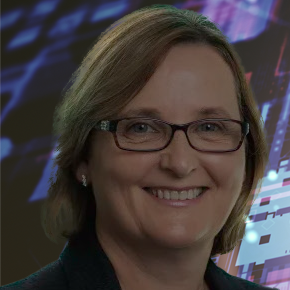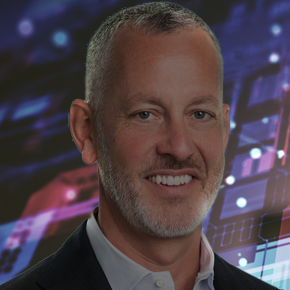
Transcript
The Partnership between aPriori and PTC is Helping Companies Achieve their Sustainability Goals.
The commitment to environmental sustainability is rippling through the manufacturing world, from lifecycle management initiatives, to promises on behalf of executives to reduce the carbon footprint of their products. But it takes smart tools to give manufacturers the kind of data they need to evaluate real trade-offs between cost, carbon and design functionality. That’s why PTC and aPriori have partnered together to deliver sustainability insights directly to design engineers, cost engineers, and sourcing professionals right within the software they’re already using every day, such as PTC Creo and other 3D CAD products.
Catherine Knicker guides PTC Strategy as the Chief Officer of Strategy and Marketing. We spoke at aPriori’s recent Manufacturing Insights Conference, where Catherine Knicker explained how PTC helps industrial and manufacturing companies incorporate sustainability throughout their entire product lifecycle, from design and manufacturing to service and end of life. We spoke about the skills and data that front-end designers need to really make a measurable impact on environmental goals. And she talked about how successful companies are empowering their decision-makers with the data and the tools they need to make the best real-time decisions for their business and for the planet. Here’s that conversation with Catherine Knicker.
87% of Customers Say Sustainability is a Strategic Goal
Leah Archibald: You have for a long time been the Chief Strategy Officer at PTC and you recently got a title change to include sustainability. Tell me about that.
Catherine Knicker: Both sustainability and marketing — so as part of my strategy remit, I’m responsible for our environmental sustainability strategy, both for PTC as a company, as well as our product, and go to market strategy for our customers. So both parts of it.
Leah Archibald: So just that little part of your story tells me that sustainability is now becoming a key part of strategy for many companies.
Catherine Knicker: Absolutely. We’ve constantly talking to our customers and at last check, 87% of our customers have some form of sustainability goal. So it’s a top three criterion for our customers. If you think about our customers, they’re all manufacturers of physical goods and topics like dematerialization, energy consumption and waste reduction are huge for them. The manufacturing sector alone accounts for, I believe, 54% of global energy consumption. So sustainability is a big issue for our customers.
Leah Archibald: Now, your customers were coming to PTC before to solve different issues, to solve manufacturing issues, to solve costing issues, to have an end-to-end solution for PLM. At what point did you see these customers starting to ask for sustainability solutions?
Catherine Knicker: It’s been over a period of time. I think there’s a lot of forces have collided together. You have investor pressure. You have regulatory pressure, which is really intensified. And then you have what everybody’s seeing happening in the world, climate change and the Paris Accord. So it’s a lot of forces all at the same time. I would say really it’s amplified in the last two plus years, but it’s been building over a long period of time.
How Does PTC Help Customers Meet ESG Targets?
Leah Archibald: So take me under the hood. What does PTC offer to your customers to help them meet their ESG targets?
Catherine Knicker: Sure. So if you step back and say, what does PTC do? We help industrial companies and manufacturing companies design, engineer, manufacture and service physical products, and we help them digitally transform the way they do that. So if you think about the product lifecycle, there are environmental components even starting at the design. To design with sustainability in mind — and that’s where we’ve had an accelerated push with our partnership with aPriori — you can help the designer and the engineer understand what they’re trading off in the design phase. Because just like cost, it’s the decisions that are made in the design phase that impact the carbon footprint of the product.
So there’s a bunch of effort there in the design stage with PTC and aPriori. But then we think about it throughout the product lifecycle. So when you go from design into operations, then there are new questions. Is there a more efficient way to produce a product so that you’re using less energy? Then you go into the service part of the lifecycle. There’s a lot from a carbon footprint standpoint there. For example, managing your spare parts. If you can produce less spare parts and if you can place those spare parts efficiently, as close to where the incident is going to occur, then you reduce embodied carbon, you reduce the energy consumption to get from A to B. And then I’d say the last piece of the product lifecycle is the whole circular notion. So when a product reaches its end of life, we want to figure out are there ways to remanufacture? Are there ways to reuse? In fact, recycling is almost the last priority. Again, that comes back to design. If you design in a modular way, you can disassemble in a modular way and then get as much reuse and remanufacture as possible and recycle. And then lastly, throw something into a landfill. That should be the last resort. So because the product is at the heart of our strategy, we’re thinking about it throughout the product lifecycle.
Leah Archibald: A lot of manufacturers talk about “end to end,” but you’ve just talked about a lot more. You are really taking the entire journey of product and integrating sustainability in every step.
Catherine Knicker: The core of the company started with 3D design. You hear a lot of people these days talk about the model based enterprise. Well, that starts with a 3D model. It’s kind of shocking to know that a lot of folks that have used 3D up in the design phase, they used it more as a efficiency tool for designing, but they’re not using some of the rich content from that model down into manufacturing and into service. And so we’re seeing a lot happen there, and that will also help with sustainability initiatives because data will flow a lot smoother into the downstream processes.
The Partnership Between PTC and aPriori
Leah Archibald: Tell me about that partnership with PTC and aPriori.
Catherine Knicker: So the core of aPriori for a long time was costing and design for manufacturability. And more recently you’ve added the downstream carbon information, both from the manufacturing process and from any of the logistics through the manufacturing process. PTC has always had an integration with aPriori between Creo, our CAD tool, and aPriori, as well as our PLM tool Windchill with aPriori. When we recently announced an expansion of the partnership with aPriori around sustainability, we figured out that one place where our customers can do a bill of material or a BOM roll up and recapture all that carbon information is in aPriori.
But I think the three things that aPriori does: 1) Cost, 2) Design for manufacturability, and 3) sustainability. they all play into this trade-off analysis that we want designers to do and therefore make better design decisions that leads to more sustainable designs.
PTC’s Science-Based Targets Initiative (SBTI)
Leah Archibald: Tell me about the term that PTC uses, which is science-based target initiative. What does it mean and what does it really mean for your customers?
Catherine Knicker: Sure. Companies who commit to science-based target say: we’re going to take a science-based approach to our carbon reduction plan. And the science-based target initiative group, or SBTI, it’s called, they don’t just take your plan and say, “Great.” They validate your plan and then they audit you on an annual basis to make sure that you’re progressing.
At PTC we’re a software company. Our footprint is not that great. I mean it’s de minimis relative to a manufacturing company. But we felt like we should eat our own dog food for two reasons. First, it’s just the right thing to do. The climate, the world, the earth needs it. And the second is it’s actually very aligned to our customers because as a vendor to our customers, we are considered a purchased good or service. And so we show up in their scope three.
So when we reduce, we are helping our customers actually meet their goal. And that’s actually the ripple effect that you’re seeing happening throughout industry. Mostly manufacturing companies will talk, and you think it’s the component suppliers and generally that’s the bulk of it. But we as a software company are a supplier. So that’s what we’re doing, both because it’s good for the world and it’s also very aligned with our customer’s goals. And honestly by doing it, we have a better appreciation for what our customers are going through. And theirs is much more complicated. Their supply chain is much more complicated.
Leah Archibald: For manufacturers who are trying to achieve science-based target initiative, it might be more challenging than for PTC because – as you say – there are so many component inputs. I would say that’s why the collaboration with aPriori is even more important because they need a source of verifiable data.
Catherine Knicker: For sure. aPriori has spent a lot of time building all of these factory models. That’s IP that’s built up over a long period of time. Supplementing that with the same downstream carbon models is hugely helpful. And making sure that source of truth is constantly updated, which you all do by default working with ecoinvent, I know the data is actionably accurate. I know I’m making the right choice.
Leah Archibald: It has been so great to talk to you, Catherine Knicker. Thank you so much.
Catherine Knicker: All right. Thank you very much.





